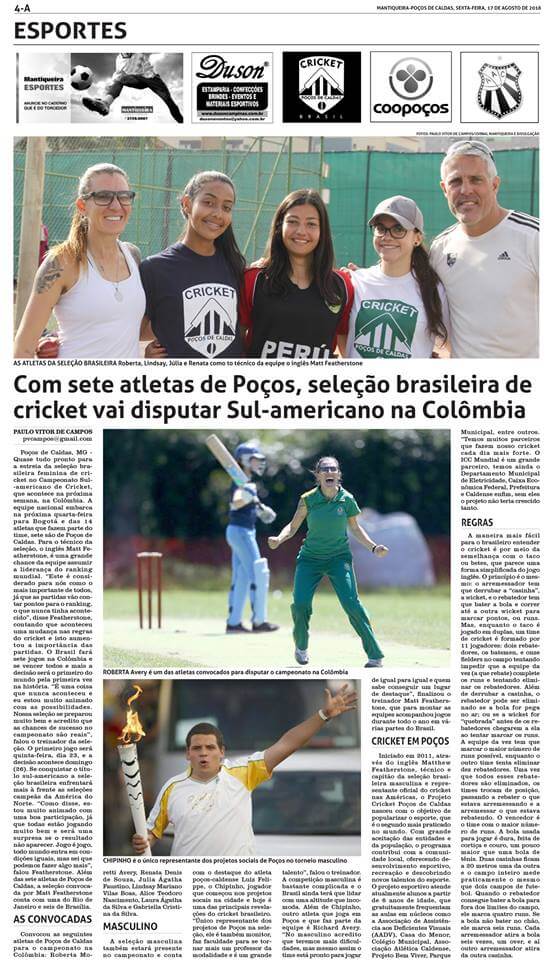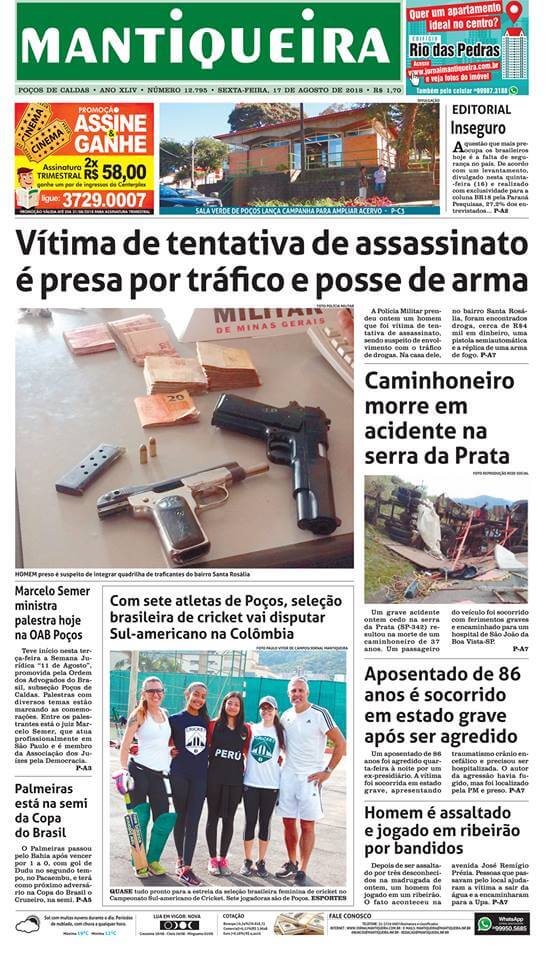Disclosure in Poços – South American Cricket Championship
Almost everything is ready for the debut of the Brazilian women’s cricket team at the South American Cricket Championship, which takes place next week in Colombia. The national team embarks next Wednesday for Bogotá and of the 14 athletes that are part of the team, seven are from Poços de Caldas. For the coach of the selection, the English Matt Featherstone, it is a great chance of the team to assume the leadership of the world ranking. “This is considered for us to be the most important of all, as the matches will count points for the ranking, which had never happened,” said Featherstone, saying that there was a change in the rules of cricket and this increased the importance of the matches. . Brazil will play seven games in Colombia and if they win all and more the decision will be the first in the world for the first time in history. “It is something that has never happened and I am very excited about the possibilities. Our team has prepared very well and I believe that the chances of success in the championship are real,” said the national team coach. The first game will be on Thursday, the 23rd, and the decision will take place on Sunday (26th). If they win the South American title, the Brazilian team will face the champion teams of North America ahead of them. “As I said, I am very excited about a good participation, since everyone is playing very well and it will be a surprise if the result does not appear. Game is game, everyone is on equal terms, but I know we can do something more”, he said Featherstone. In addition to the seven athletes from Poços de Caldas, the selection convened by Matt Featherstone has one from Rio de Janeiro and six from Brasília.
The summons from Poços de Caldas
He summoned the following athletes from Poços de Caldas to the championship in Colombia: Roberta Moretti Avery, Renata Denis de Souza, Julia Ágatha Faustino, Lindsay Mariano Vilas Boas, Alice Teodoro Nascimento, Laura Ágatha da Silva and Gabriella Cristina da Silva.
Male
The male team will also be present in the championship and has the highlight of the athlete well-caldense Luiz Felippe, Chipinho, player who started in social projects in the city and today is one of the main revelations of Brazilian cricket. “The only representative of the Poços projects in the selection, he is also a monitor, goes to college to become another teacher of the sport and is a great talent”, said the coach. The male competition is quite complicated and Brazil will still have to deal with an altitude that is uncomfortable. In addition to Chipinho, another athlete who plays in Poços and is part of the team is Richard Avery. “In the men’s game, I believe we will have more difficulties, but even so the team is ready to play as an equal and who knows how to get a place of prominence”, concluded the coach Matt Featherstone, who to assemble the teams followed games throughout the year various parts of Brazil.
Cricket in Poços
Started in 2011, through Englishman Matthew Featherstone, coach and captain of the Brazilian male team and official representative of cricket in the Americas, the Cricket Project Poços de Caldas was born with the aim of popularizing the sport, which is the second most practiced in the world. With great acceptance from entities and the population, the program contributes to the local community, offering sports development, recreation and discovering new sports talents. The sports project currently serves students from 6 years of age, who attend classes free of charge in centers such as the Association for the Assistance of the Visually Impaired (AADV), Casa do Menor, Municipal School, Caldense Athletic Association, Bem Viver Project, Municipal Park , between others. “We have many partners who make our cricket stronger every day. The ICC Mundial is a great partner, we also have the Municipal Department of Electricity, Caixa Econômica Federal, City Hall and Caldense anyway, without them the project would not have grown so much.
Cricket
The easiest way for the Brazilian to understand cricket is through the resemblance to the bat or betes, which looks like a simplified form of the English game. The principle is the same: the pitcher has to knock down the “little house”, the wicket, and the hitter has to hit the ball and run to the other wicket to score points, or runs. But, while the bat is played in pairs, a cricket team is made up of 11 players: two batters, the batsmen, and eleven fielders on the field trying to prevent the team of the time (the one batting) from completing the runs and trying to eliminate the hitters. In addition to knocking down the box, the hitter can be eliminated if the ball is caught in the air; or if the wicket is “broken” before the batters reach it when trying to score the runs. The next team has to score as many runs as possible, while the other team tries to eliminate ten hitters. Once all these hitters are eliminated, the teams change positions, starting to hit what they were shooting and to throw what they were hitting. The winner is the team with the most runs. The ball used to play is hard, made of cork and leather, slightly larger than a tennis ball. Two little houses are 20 meters from each other and the entire field measures practically the same as two football fields. When the hitter manages to hit the ball out of bounds, he scores four runs. If the ball does not hit the ground, he scores six runs. Each pitcher throws the ball six times, one over, and then another pitcher shoots from the other box.



